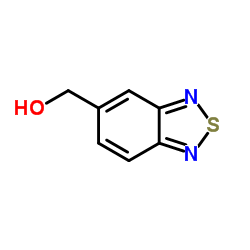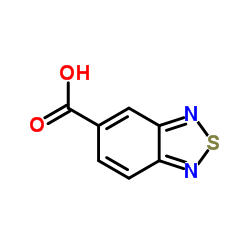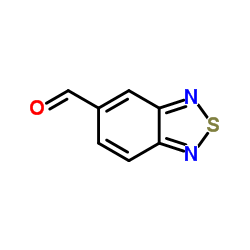89795-51-7
| Name | 2,1,3-Benzothiadiazol-5-ylmethanol |
|---|---|
| Synonyms |
5-Hydroxymethyl-benz-<2,1,3>-thiadiazol
2,1,3-Benzothiadiazol-5-ylmethanol 2,4,6-TRIBROMOBIPHENYL 2,1,3-Benzothiadiazole-5-methanol 5-hydroxymethylbenzo-2,1,3-thiadiazole |
| Density | 1.5±0.1 g/cm3 |
|---|---|
| Boiling Point | 313.5±17.0 °C at 760 mmHg |
| Melting Point | 61-63ºC |
| Molecular Formula | C7H6N2OS |
| Molecular Weight | 166.200 |
| Flash Point | 143.4±20.9 °C |
| Exact Mass | 166.020081 |
| PSA | 74.25000 |
| LogP | 0.80 |
| Vapour Pressure | 0.0±0.7 mmHg at 25°C |
| Index of Refraction | 1.728 |
Synonym: Section 2 - COMPOSITION, INFORMATION ON INGREDIENTS
Risk Phrases: None Listed. Section 3 - HAZARDS IDENTIFICATION EMERGENCY OVERVIEW
Not available. Potential Health Effects Eye: May cause eye irritation. Skin: May cause skin irritation. May be harmful if absorbed through the skin. Ingestion: May cause irritation of the digestive tract. May be harmful if swallowed. Inhalation: May cause respiratory tract irritation. May be harmful if inhaled. Chronic: Not available. Section 4 - FIRST AID MEASURES Eyes: Flush eyes with plenty of water for at least 15 minutes, occasionally lifting the upper and lower eyelids. Get medical aid. Skin: Get medical aid. Flush skin with plenty of water for at least 15 minutes while removing contaminated clothing and shoes. Ingestion: Get medical aid. Wash mouth out with water. Inhalation: Remove from exposure and move to fresh air immediately. Notes to Physician: Treat symptomatically and supportively. Section 5 - FIRE FIGHTING MEASURES General Information: As in any fire, wear a self-contained breathing apparatus in pressure-demand, MSHA/NIOSH (approved or equivalent), and full protective gear. Extinguishing Media: Use water spray, dry chemical, carbon dioxide, or chemical foam. Section 6 - ACCIDENTAL RELEASE MEASURES General Information: Use proper personal protective equipment as indicated in Section 8. Spills/Leaks: Vacuum or sweep up material and place into a suitable disposal container. Section 7 - HANDLING and STORAGE Handling: Avoid breathing dust, vapor, mist, or gas. Avoid contact with skin and eyes. Storage: Store in a cool, dry place. Store in a tightly closed container. Section 8 - EXPOSURE CONTROLS, PERSONAL PROTECTION Engineering Controls: Use adequate ventilation to keep airborne concentrations low. Exposure Limits CAS# 89795-51-7: Personal Protective Equipment Eyes: Not available. Skin: Wear appropriate protective gloves to prevent skin exposure. Clothing: Wear appropriate protective clothing to prevent skin exposure. Respirators: Follow the OSHA respirator regulations found in 29 CFR 1910.134 or European Standard EN 149. Use a NIOSH/MSHA or European Standard EN 149 approved respirator if exposure limits are exceeded or if irritation or other symptoms are experienced. Section 9 - PHYSICAL AND CHEMICAL PROPERTIES Physical State: Solid Color: brown Odor: pleasant odor pH: Not available. Vapor Pressure: Not available. Viscosity: Not available. Boiling Point: Not available. Freezing/Melting Point: 61 - 63 deg C Autoignition Temperature: Not available. Flash Point: Not available. Explosion Limits, lower: Not available. Explosion Limits, upper: Not available. Decomposition Temperature: Solubility in water: Specific Gravity/Density: Molecular Formula: C7H6N2OS Molecular Weight: 166.2 Section 10 - STABILITY AND REACTIVITY Chemical Stability: Not available. Conditions to Avoid: Incompatible materials. Incompatibilities with Other Materials: Oxidizing agents, reducing agents, acids, bases. Hazardous Decomposition Products: Nitrogen oxides, carbon monoxide, oxides of sulfur, carbon dioxide. Hazardous Polymerization: Has not been reported Section 11 - TOXICOLOGICAL INFORMATION RTECS#: CAS# 89795-51-7 unlisted. LD50/LC50: Not available. Carcinogenicity: 2,1,3-Benzothiadiazol-5-ylmethanol - Not listed by ACGIH, IARC, or NTP. Section 12 - ECOLOGICAL INFORMATION Section 13 - DISPOSAL CONSIDERATIONS Dispose of in a manner consistent with federal, state, and local regulations. Section 14 - TRANSPORT INFORMATION IATA No information available. IMO No information available. RID/ADR No information available. Section 15 - REGULATORY INFORMATION European/International Regulations European Labeling in Accordance with EC Directives Hazard Symbols: Not available. Risk Phrases: Safety Phrases: S 24/25 Avoid contact with skin and eyes. WGK (Water Danger/Protection) CAS# 89795-51-7: No information available. Canada None of the chemicals in this product are listed on the DSL/NDSL list. CAS# 89795-51-7 is not listed on Canada's Ingredient Disclosure List. US FEDERAL TSCA CAS# 89795-51-7 is not listed on the TSCA inventory. It is for research and development use only. SECTION 16 - ADDITIONAL INFORMATION N/A |
| Safety Phrases | 24/25 |
|---|---|
| HS Code | 2934999090 |
|
~79% 
89795-51-7 |
| Literature: SMITHKLINE BEECHAM P.L.C. Patent: WO2003/87098 A1, 2003 ; Location in patent: Page/Page column 39 ; |
|
~% 
89795-51-7 |
| Literature: J. Gen. Chem. USSR (Engl. Transl.), , vol. 34, p. 1272 - 1276,1270 - 1273 |
|
~% 
89795-51-7 |
| Literature: Journal of Medicinal Chemistry, , vol. 47, # 12 p. 3163 - 3179 |
| Precursor 3 | |
|---|---|
| DownStream 1 | |
| HS Code | 2934999090 |
|---|---|
| Summary | 2934999090. other heterocyclic compounds. VAT:17.0%. Tax rebate rate:13.0%. . MFN tariff:6.5%. General tariff:20.0% |



